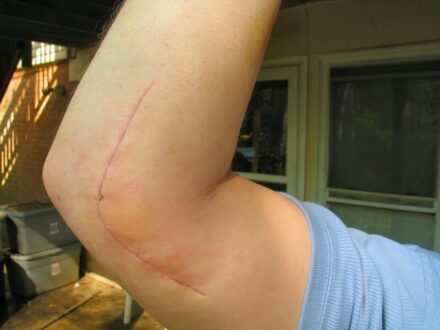What is Submuscular ulnar nerve transposition?
Submuscular ulnar nerve transposition is a surgical process that is done for Cubital Tunnel Syndrome. The pressure on the ulnar nerve at the elbow causes the Cubital Tunnel Syndrome. Cubital Tunnel Syndrome is the type of Nerve entrapment or Nerve compression syndrome that occurs when a nerve is entrapped, compressed, or restricted. Whenever a nerve is trapped, compressed, or limited, it fails to function correctly.
The ulnar nerve is involved in the hand and forearm movements. It also plays a role in the sensation of the medial one (small finger) and one half (ring finger) digits. Since the ulnar nerve is compressed in the patients with the Cubital Tunnel Syndrome, they face difficulty in handling and gripping objects. The patients often feel pain, prickliness, and hypoesthesia. The surgery is done to relieve the pressure on the ulnar nerve. If the surgery is performed to bring the ulnar nerve from behind the elbow to the front of the elbow, it is called the Anterior ulnar nerve transposition.
The surgery for the relocation of the ulnar nerve on the top of the muscle but under the skin is called Subcutaneous Ulnar Nerve Transposition. The Submuscular Ulnar Nerve transposition is the placement of the ulnar nerve under the muscle. The advantage of the Submuscular Ulnar Nerve Transposition over the other transpositions is that it has fewer recurrences. It protects the ulnar nerve since it is placed under the muscle and is, therefore, best for patients with previous failed surgeries.
Submuscular ulnar nerve transposition rehab protocol
The patients who had submuscular ulnar nerve transposition have to undergo rehabilitation after surgery. A proper protocol must be followed for the rehabilitation, which is further divided into various weeks and phases. The rehabilitation aims to recoup the mobility of the elbow and the agility and strength of the hand. On the third day of post-surgery, the wound dressing is removed while the wound closure strips are left. The patient has to wear an arm sling for two weeks post-surgery to limit the movement of the elbow, maintain the position of the ulnar nerve and avoid the complete or partial dislocation of the joint after transposition.
Phase-1:
Phase-1 is also known as the immediate post-operative phase. This phase is 0-2 weeks.
Goal: The goals of phase-1 are as follow:
· Reduce pain
· Control oedema
· Promote tissue healing
· Protect surgical site
· Promote elbow range of motion (ROM)
Week 0-2 Intervention:
· Wear a sling to maintain an angle of 90 degrees around the bent elbow with wrist free for movement.
· Initiate an active range of motion (AROM) for the hand and wrist.
· Gripping exercises.
· Initiate isometrics for shoulder, elbow, and wrist.
Phase-2:
Phase-2 is also known as the intermediate phase. This phase is of 3-7 weeks.
Goal: The goals of phase-2 are as follow:
· Regain full range of motion
· Improve the strength and stamina of upper extremity
· Progressive increase of functional range
· Promote the AROM of the elbow at 0-145 degrees
Week 3-7 Intervention:
· Halt the use of the sling
· Full extension of elbow ROM
· Progress to flexibility and strengthening exercises focusing on extension and flexion of the elbow, shoulder, and wrist and supination and pronation of the forearm.
· Initiate light sports activities.
Phase-3:
Phase-3 is also known as the advance strengthening phase. This phase is of 8-12 weeks.
Goal: The goals of phase-3 are as follow:
· Steady return to regular activities.
· Progress to increasing muscular control of upper extremity.
· Increase sporting activities.
Week 8-12 Intervention:
· Progress to eccentric strengthening exercises.
· Progress to plyos or jump training
· Continue flexibility and strengthening exercises
Phase-4:
Phase-4 is also known as the return to the activity phase. This phase is of 14-32 weeks.
Goal: The goals of phase-4 are as follow:
· Steady return to regular activities.
Week 14-32 Intervention:
· Return to the physically demanding sports and work.
Submuscular ulnar nerve transposition recovery time
The recovery time of the Submuscular Ulnar Nerve Transposition depends upon the condition of the muscle or the nerve. The nerve only grows one inch a month, so it may take several months to heal. If there is nerve or muscle damage, it will take a much longer time. The full recovery after Submuscular Ulnar Nerve Transposition can be seen in 3-6 months. Still, some factors like the patient’s health before surgery, the gravity of the illness, and the patient’s response to physical therapy also affect recovery time.
For the patients who had severe damage, complete healing is not possible. After the surgery, the patient has to wear a sling for about 2-4 weeks. The sling around the elbow aids in maintaining an angle of 90 degrees, which will help the ulnar nerve to secure its position and the wound to heal properly. After the removal of the splint, physical therapy is started. Physical therapy will help to regain the complete range of motion of the elbow.
Submuscular ulnar nerve transposition post-op care:
After the surgery, the patient has to wear a sling for the ulnar nerve’s placement at its position and healing of the incision. The patient can continue his regular diet after discharge. Bathing and swimming should be avoided until the removal of the dressing. The incision should be kept dry until the removal of the incision. To decrease pain and swelling, the arm should be elevated, and cold therapy should be used. The wound should be checked for any bleeding, pus, severe pain, hypoesthesia and foul odour. The temperature should be checked regularly. Visit the hospital for the follow up.
 Health & Care Information
Health & Care Information 


